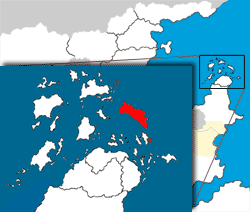Country Info: Yamamoto (and Seiguntou)
 
|
| Terminology: | Yamamotoan (yah-mah-MOH-toh-an) people, one Yamamotoan, many Yamamotoans Seiguntouan (say-GUN-toh-an) people, one Seiguntouan, many Seiguntouans |
| Capital: | Kaminoke (kah-MEE-noh-kay)
The capital of Seiguntou is Jiyoma (gee-YOH-mah), or "Gioma" as spelled by Delonans. |
| Monarch: | Officially, the Emperor Makoto. The Shogun Ikoma holds the real power.
Seiguntou is ruled by a Viceroy, Yukinaga Mizuho. |
Yamamoto (yah-mah-MOH-toh) is an archipelago across the Great Sea, far to the east. It discovered Hesket in 993, but initial contact was not positive, leading it to invade Delona in 997. It now possesses some Delonan islands, calling its holdings Seiguntou (say-GUN-toh).
The many differences between Yamamotoan and Hesketine culture mean that the two continents often do not understand one another.
History
Yamamotoan explorers sailed west, reaching Hesket, in 993. They sailed north along the coast and attended the Loch Meagan conference (the conference in Cadfaigh to settle the fate of Ragnorack), hoping to act as neutral arbiters.
When the Caelti rose up in rebellion, the Yamamotoans saw one side with a dragon fighting another side. While Hesketine dragons are vicious and vile, the dragons of Yamamoto are benevolent and wise; to the Yamamotoans it was clear that the Caelti were in the right. Caelti-Yamamotoan friendship was further cemented when one of the Yamamotoan dignitaries married Riallonna, the leader and "princess" of the Caelti. As the Caelti rebellion intensified, the Yamamotoans returned to their homeland, bringing Riallonna with them. Across Hesket the opinion of the easterners dropped, and relations between the two continents got off to a rocky start.
The Yamamotoans would soon learn the true nature of the Caelti and their practices. Horrified, they executed the Caelti among their number, and now believed that all Hesketines, not just Caelti, were "baby-killers." Political maneuvering among factions of Yamamotoan nobles led to the nomination of the country's first Shogun, Ikoma (ee-KOH-mah) Harunobu. The new Shogun was charged by Emperor Makoto (mah-KOH-toh) to take power and defend the country against the "dragon-slaying baby-killing barbarians" of Hesket. Not all the nobles were keen on the idea of a Shogun, so Ikoma found himself needing to justify his new position. What better way, he thought, than a war against the barbarians.
The Invasion of Delona
Yamamoto invaded Delona, the easternmost part of Hesket, in July 997. The invasion went far worse than the Yamamotoans expected, in part because the Delonans were warned by a ship who discovered the impending invasion a few days ahead of time.
The ship also revealed that Yamamoto planned to conquer all of Hesket, so Napermo and Veneza made appeals to the other kingdoms of Hesket for assistance; many complied.
At the war's height, these countries were involved:
- Declarations of war: Veneza, Giodonia, Crescia, Trenzano, Philiathos
- Sending troops: Vallino, Uffabria, Melonissos, Alguria, Pastoccia, Roccatina, Tamplonia, Allondell, Chardreau
- Providing other support (arms, money): Iñarra, Tregamo, Castagna, Praterra, Crissimo, Brevano, Massulia
- Pledging solidarity: Linneraigh, Roudoigne, Valenne, Kislevia
By December 997, Yamamoto had captured the Duchy of Napermo and a few other islands belonging to other lands. The Hesketines were only able to expel the Yamamotoans from the Venezan possession of Frignenza in the summer of 998. Heady with optimism, the Delonans mounted an attack on occupied Napermo, aimed at the port city of Salicusa. The attack proved to be a bloody disaster for both sides, with only stragglers making it back to Veneza and thousands of Yamamotoans left dead. (A second attack in September 998 fared no better.)
The war slogged on for a year and a half, as further Hesketine charges failed, and as the Yamamotoans proved unable to advance further than their current holdings. Despite protests from the more staunch Delonan warriors (and the Rannashites and other factions), Prince Alonzo of Veneza, the de facto leader of the Delonan forces, met with a Yamamotoan envoy in the spring. After much negotiations, the two sides agreed first to a cease-fire and, on April 23, 999, a peace treaty. Veneza, Philiathos, Melonissos and Giodonia agreed to acknowledge the loss of territory (and the loss of all of Napermo) to Yamamoto, who in turn agreed to treat the residents of the conquered territories fairly and to allow pilgrims to reach religious sites (especially Nicolia, which now lay within Seiguntou.) The peace treaty was not universally welcomed, with some (especially Napermians) considering it a "sell-out", but with others believing that an end to the ongoing bloodshed was more important than liberating Napermo.
Seiguntou Today
Meaning "Western Archipelago," Seiguntou is the Yamamotoan holding in Hesket. Once part of Delona, Seiguntou includes the former Duchy of Napermo, plus a number of other smaller islands once belonging to Philiathos and Veneza. Most of Seiguntou's residents are of Hesketine origin, and there is considerable resistance to its foreign rule.
Seiguntou also possesses the island of Nicolia, once a Venezan holding. This small island north and east of Veneza proper is the home of the Temple of Nicolian Waters, the largest known temple to Kyta. The temple was once frequented by scores of peasants seeking to bathe and purify in its healing waters. Given the recent war, however, visitors are few.
Seiguntou also includes the tiny and mostly uninhabited island of Eastgate, which lies over a hundred miles east of Delona proper. (The Yamamotoans call this island "Seikojima," or "tiny western island.") Yamamoto uses Seikojima as a waypoint on its shipping route from Yamamoto to Seiguntou, and it is believed that the Yamamotoans have cleared the island of any former inhabitants.
(Since only Yamamoto has ocean-crossing vessels and they rarely sail to Hesket, players will need permission from the Game World Committee to create a character who is from Yamamoto or any other Dosanese land.)
Monarch
Officially, the Emperor Makoto. However, the Shogun Ikoma holds the real power.
Seiguntou is ruled by the Viceroy, Yukinaga Mizuho. Little is known about her.
Nobles
Ruled by an Emperor, officially, while the Shogun ("overlord") holds real power. Under the Emperor are the daimyo (a term which equates to baron or count). Seiguntou is currently run by a military-style administration and has not yet been divided into feudal territories.
